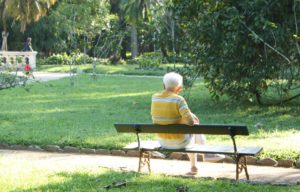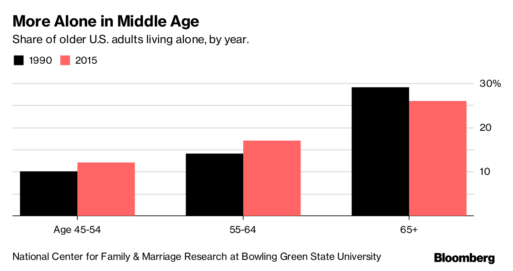More American adults may die alone in the future, if recent studies are any indication.
 This would be largely due to the fact that Americans are much more independent nowadays compared to earlier generations. Roughly half of U.S. adults are single. Those that choose to get married are waiting longer to do so, and they’re also having smaller families.
This would be largely due to the fact that Americans are much more independent nowadays compared to earlier generations. Roughly half of U.S. adults are single. Those that choose to get married are waiting longer to do so, and they’re also having smaller families.
A 2015 study conducted by the National Center for Family and Marriage Research compared the living situations of U.S. adults in 1990 and 2015. Thirteen percent of American adults lived alone in 2015, a rise of only one percent from 1990. However, different age groups had different living situations.
Those 65 and over are living alone less often than their counterparts from 1990. This is partly because of longevity, in that fewer older people are widowed. The percentage of people under 45 years who live alone did not change. What alarmed some researchers, though, is that more Americans aged 45 to 65 are living alone than in years past.

Credit: Bloomberg.com
Researchers are worried that this trend may mean that many older people will feel isolated as they age, particularly those with no close living relatives. Sociologists Rachel Margolis and Ashton Verdery penned a report earlier this year which attempted to calculate how many Americans fall into this category.
Analyzing data from 1998 to 2010, they found that 6.6 percent of U.S. adults 55 and older have neither a still-living spouse nor children. One percent have essentially no relatives to speak of, including a partner, children, parents or siblings.
Isolation Rates Expected To Rise
Those figures are expected to increase. Divorce rates nearly doubled for adults aged 55 to 65 from 1990 to 2015. People are also remarrying after divorce less often than they used to. Seniors in the future will also have fewer siblings and children to ask for help or interact with. Baby boomers and generations before tended to live in large families. However, women today are having fewer children (the fertility rate dropped 26 percent from 1970 to 2015), and single-child families are on the rise.
Margolis and Verdery predict that the rate of older Americans without any living kin will surge in the next 40 years or so. In a recently published study, they used more than 100 years of Census Bureau information to track American families. They predict that the number of non-Hispanic whites with no living close kin will double by 2060; the number for non-Hispanic blacks is expected to more than triple. (Lack of immigration data made it harder to study other racial groups.)
In order to tackle this issue, the U.S. needs better housing options for older adults, says New York University sociology professor Eric Klinenberg. Social attitudes may also need to change in order for older people to stay connected as they age.
“Our society is evolving quickly,” says Klinenberg, “but probably not quickly enough.”
Humans are social beings. Strong relationships boost our overall sense of happiness and well-being. In fact, an in-depth study from 2010 showed that humans with healthy social lives had a 50 percent better chance of survival than those who did not. With these ideas in mind, we need to think of ways to address isolation in older adults, a problem that will surely increase in the years to come.

 In the Future, More Older Americans May Die Alone
In the Future, More Older Americans May Die Alone


 “Hand to Earth” by Andy Goldsworthy
“Hand to Earth” by Andy Goldsworthy

 Caring for a Dying Loved One? Be Gentle With Yourself.
Caring for a Dying Loved One? Be Gentle With Yourself.














